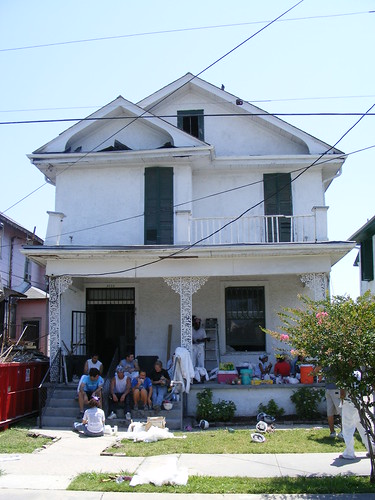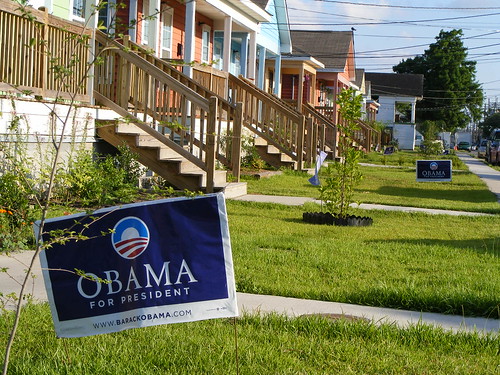 The house I helped gut while in New Orleans with a group from the University of Maryland.
The house I helped gut while in New Orleans with a group from the University of Maryland.Civic activist/all-around involved person Alan Bowser just posted a slideshow from the Montgomery Blair Katrina Run-O-Vation, organized by a group of Blair students to raise money for the ongoing reconstruction of New Orleans. I was impressed to see that the money's going to Hands On New Orleans, a group whose hostel I stayed in while down there last May. Henry from Silver Spring Scene's been bugging me to write about it already, and I probably should.
Seeing hundreds of Silver Springers running through Sligo Creek Park in support of New Orleans makes my heart swell, especially as the city's threatened by Hurricane Gustav. I couldn't help but think about all of the places I saw while in New Orleans - the neatly-restored houses in the Garden District, where I stayed; the house our group from Maryland worked to restore on General Taylor Street; and all the homes and schools and businesses that are still as they were when the floodwaters receded three years ago.
Do these places survive another hurricane? And if they don't, are they still worth coming back to? It's a question that weighs heavily on the minds of anyone who lives in New Orleans - or just came for a visit and wishes they could live there.
BELOW: Musicians' Village, a Habitat for Humanity development for local musicians displaced by Katrina; and the auditorium of Louis Armstrong Elementary School in New Orleans' Lower Ninth Ward, which was destroyed when a levee along Industrial Canal burst.



1 comment:
You know, if I owned a property, that was destroyed in Katrina and was still in the state in which the storm had left it, I'd start thinking differently about "what is a house" and "what makes a home".
Of course, I don't expect that most people would look at this the way that I would; for most people a house is a house, that is to say, it's a traditional wood frame building, perhaps with bricks or vinyl over some or all of the wood facings, all on some sort of foundations.
But let's depart from that common view and re-examine a view that's just as commonplace in the modern day, that a house is a machine for living. What does such a house need?
It needs interior climate control, it needs plumbing, and it needs to provide shelter.
In certain parts of New Orleans, it needs to either be able to withstand a hurricane, or to be so inexpensive that it doesn't matter if a hurricane flattens it. Indeed, it might be a good investment and engineering decision to make it collapsible in a way that will effectively incapable of being further collapsed by a hurricane.
There are parts of the country where people who do the 'experimental living' thing are pretty happy living in a Yurt. New Orleans is a bit warm and wet for that, and for all too many people, their idea of a "house" is a place to store stuff. That attitude might -- and perhaps should -- be the biggest casualty of Katrina and comparable disasters. Who needs all that much "stuff"?
Some would say that without all of the relentless consumerism that characterizes the modern US, we'd have little need for our heavy industries and distribution and marketing systems and lots of people would be put out of work. Well, most of our heavy industrial manufacturing is done overseas nowadays, so that argument falls flat.
People once lived fairly simply, and fairly well in many cases. Do we need all of that "stuff"? Isn't there a simple "essential core" of what makes a home, and isn't a lot of that something that could be easily made mobile, or already mobile?
Katrina didn't so much destroy things like stoves or bathtubs or refrigerators -- or the watermains or sewer lines in the ground -- as it destroyed wood and sheetrock and the things attached to the wood and sheetrock. Replacing what was destroyed is the greatest cost, and that is what will again be destroyed when another Category Five storm sweeps the area, as is statistically inevitable.
So, I propose that places that were so badly wrecked as to have been left in-status in-situ should simply have the wreckage cleared. Rebuilding the same thing that was destroyed before, on the notion of selling structure as capital improvement on real estate, is just throwing bad money after good. I think everyone realizes this.
So, tear it all down. Pull out the appliances and if they can be made to work, prepare to re-use them. Prepare extremely solid and storm-proof footings around the places where plumbing goes belowground. After all, clean public water and effective waste removal are the core amenities of any city or town in the modern world, utterly indispensible. That's the real investment and that is what needs to be valued and protected. Protect the sanitation core of the property and you could put a tent around it and you would in fact be living the civilized life with the addition of nothing more than a refrigerator and stove.
If you're thinking "but the function of a house is to provide shelter, and a place to put 'stuff'", remember that this discussion got started when considering the wreckage of houses that simply could not perform that function. Stop thinking that way about houses, when you live in a place where the forces of nature can provide far more ready destruction than human engineering can provide defense against that destructiveness.
You can't hide from something like Katrina; you have to run. And you want to take as much with you as you can, so when you rebuild, spend your money creating a nearly indestructible "central sanitation core". Build your kitchen on a structure that can be mobilized.
For example, imagine a sort of giant dumbwaiter or a platform that can be lowered onto a trailer, which holds your stove and refrigerator and kitchen sink and dishwasher and medicine cabinet and leaves room for a small generator. Category Five a-comin'? Pull the trailer up, disconnect from the sanitation core, lower your kitchen onto the trailer and cover it for travel, cap the sanitation core, and haul your butt outta town.
You'll be taking with you every thing of value and essential function, and all you'll be leaving behind you are the bedrooms. If you built the bedrooms out of materials that are cheap and collapsible and mold-proof, you'll come home after the storm to a well-anchored pile and you can just prop it all upright and reset the binding pins and jack the kitchen back into place and you're back in business.
------
Now, is this the way to build a house in Maryland? Not even. That wouldn't be all that appropriate here, where we have almost no risks of being flooded for months after a Category Five hurricane that is statistically certain to come every 50 years. That would, however, be an extremely sensible way to build a house anywhere under the 20-foot storm surge line on any of the Gulf or Atlantic coasts.
Post a Comment